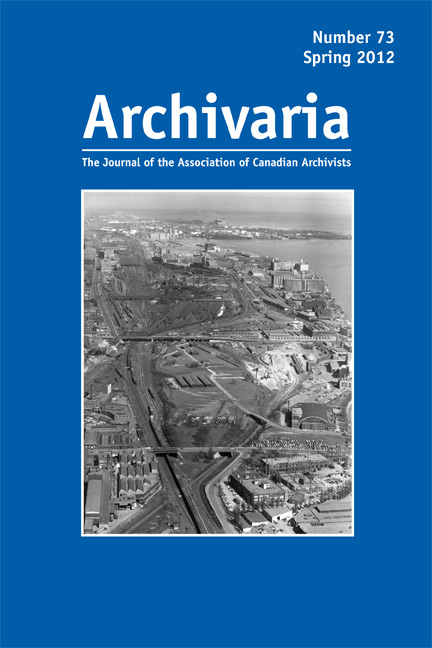The Conceptual Fonds and the Physical Collection
Abstract
This paper examines ideas about the fonds, the collection, and the intersections between them. Archivists usually assume that “artificial” collections and “organic” fonds are mutually exclusive categories, but the author argues that rigid distinctions between “artificial” and “organic” are unsupportable. Instead, if there is a critical difference between collection and fonds, it lies in the understanding that collections are physical or material, whereas fonds are conceptual entities whose membership need not be physically brought together. Fonds are difficult to circumscribe, both because there is potential for a multiplicity of overlapping fonds and because their boundaries are open to interpretation. Identification of collections is less subjective; although they can be re-formed over time and their internal orderings need not be fixed, their external borders at any given moment are usually easy to recognize. The paper concludes by exploring some possible ways in which archivists might document both fonds and collections and expose their current and past relationships.
RÉSUMÉ
Cet article examine certaines idées au sujet du fonds, de la collection et du croisement entre eux. Les archivistes présument habituellement que les collections « artificielles » et les fonds « organiques » sont des catégories qui s’excluent mutuellement, mais l’auteur affirme que les distinctions rigides entre « artificiel » et « organique » sont sans fondement. Au contraire, s’il existe une différence cruciale entre collection et fonds, elle se trouve au niveau de la compréhension qu’une collection est physique ou matérielle, alors qu’un fonds est une entité conceptuelle qui ne requiert pas que les parties constituantes soient rassemblées physiquement. Les fonds sont difficiles à circonscrire, d’abord parce qu’il existe un potentiel que plusieurs fonds se chevauchent les uns les autres, et aussi parce que leurs limites sont sujet à interprétation. L’identification des collections est moins subjective; bien qu’elles puissent être reconstituées avec le temps et que leur classement interne n’ait pas besoin d’être revu, on arrive assez facilement à reconnaître leurs limites externes, et ce, à n’importe quel moment. Cet article conclut en explorant diverses façons dont les archivistes pourraient documenter les fonds et collections et exposer leurs liens actuels et passés.
Authors of manuscripts accepted for publication retain copyright in their work. They are required to sign the Agreement on Authors' Rights and Responsibilities that permits Archivaria to publish and disseminate the work in print and electronically. In the same agreement, authors are required to confirm that "the material submitted for publication in Archivaria, both in its paper and electronic versions, including reproductions of other works (e.g. photographs, maps, etc.) does not infringe upon any existing copyright." Authors of manuscripts accepted for publication retain copyright in their work and are able to publish their articles in institutional repositories or elsewhere as long as the piece is posted after its original appearance on archivaria.ca. Any reproduction within one year following the date of this agreement requires the permission of the General Editor.





